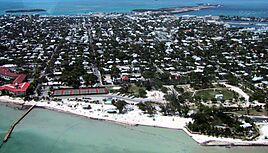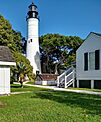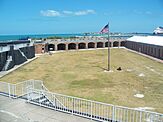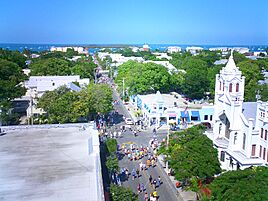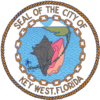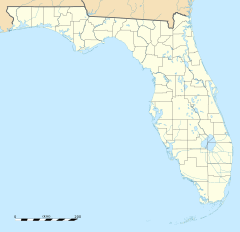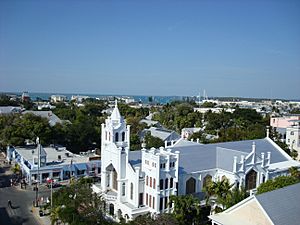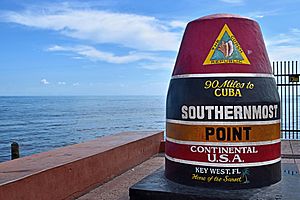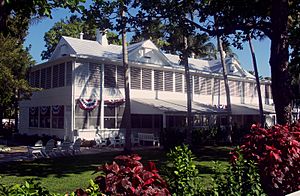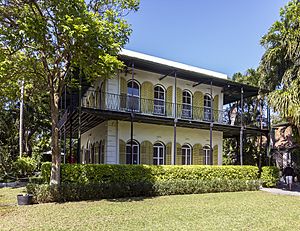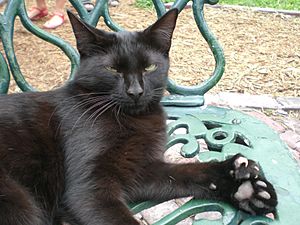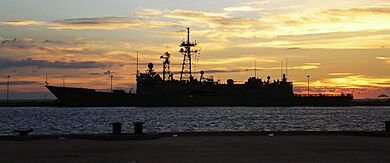Key West facts for kids
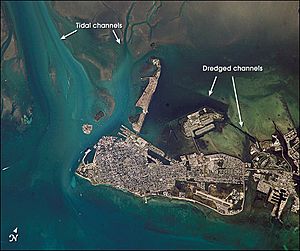
An October 2002 NASA image of Key West from space
|
|||
| Geography | |||
|---|---|---|---|
| Coordinates | 24°33′55″N 81°46′33″W / 24.565176°N 81.775794°W | ||
| Archipelago | Florida Keys | ||
| Area | 4.2 sq mi (11 km2) | ||
| Length | 4 mi (6 km) | ||
| Width | 1 mi (2 km) | ||
| Highest elevation | 18 ft (5.5 m) | ||
| Highest point | Solares Hill, 18 ft (5.5 m) above sea level | ||
|
Aerial view of Key West (2001)
Duval Street with St. Paul's Episcopal Church (2004)
|
|||
|
|||
| Nickname(s):
"The Conch Republic"
"Southernmost City in the Continental United States" |
|||
| Motto(s):
One Human Family
|
|||
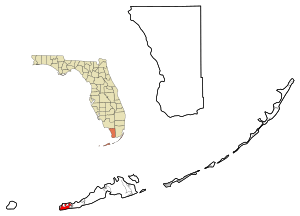
Location in Monroe County and the state of Florida
|
|||
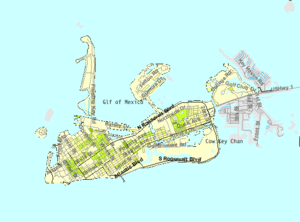
U.S. Census Bureau map showing city limits
|
|||
| Country | |||
| State | |||
| County | Monroe | ||
| Government | |||
| • Type | Commission–Manager | ||
| Area | |||
| • Total | 7.21 sq mi (18.67 km2) | ||
| • Land | 5.60 sq mi (14.50 km2) | ||
| • Water | 1.61 sq mi (4.17 km2) | ||
| Elevation | 5 ft (2 m) | ||
| Population
(2020)
|
|||
| • Total | 26,444 | ||
| • Density | 4,722.99/sq mi (1,823.44/km2) | ||
| Time zone | UTC−5 (Eastern (EST)) | ||
| • Summer (DST) | UTC−4 (EDT) | ||
| ZIP Codes |
33040, 33041, 33045
|
||
| Area codes | 305, 786, and 645 | ||
| FIPS code | 12-36550 | ||
| GNIS feature ID | 0294048 | ||
Key West is an island located in the Straits of Florida, part of the U.S. state of Florida. It's not just one island! It also includes parts of other islands like Sigsbee Park, Fleming Key, Sunset Key, and the northern part of Stock Island. Together, these make up the City of Key West.
The island of Key West is about 4 miles (6.4 km) long and 1 mile (1.6 km) wide. Its total land area is about 4.2 square miles (10.9 km2). Key West is located about 130 miles (209 km) southwest of Miami by air. By road, it's about 165 miles (266 km) away. It's also quite close to Cuba, only about 95 miles (153 km) north of Cuba at its closest point.
The city of Key West is the main city of Monroe County. This county includes most of the Florida Keys and part of the Everglades. The city's total land area is about 5.6 square miles (14.5 km2). In 2020, about 26,444 people lived within the city limits. The city's official saying is "One Human Family".
Key West is the southernmost city in the contiguous United States. It is also the westernmost island in the Florida Keys that is connected by a highway. Duval Street, the main street, is 1.1 miles (1.8 km) long. It stretches from the Gulf of Mexico to the Straits of Florida and the Atlantic Ocean. Key West is the end point of U.S. Route 1, which is the longest north-south road in the United States. It's also the end of Florida State Road A1A and the East Coast Greenway. Before 1935, it was also the end of the Florida East Coast Railway.
Key West is a popular stop for cruise ships. The Key West International Airport offers airline services. Naval Air Station Key West is an important training spot for the Navy all year. This is because of its warm, tropical weather. This weather is also why President Harry S. Truman chose Key West for his Winter White House. The main shopping and business area is along Duval Street. It covers much of the northwestern part of the island.
Contents
Exploring Key West's Past
Early History of Key West
Before the 1800s, groups like the Calusa and Tequesta people lived on Key West. The last Native American residents were Calusa who moved to Cuba in 1763. This happened when Florida was given from Spain to Great Britain.
The original Spanish name for Key West is Cayo Hueso (pronounced KAH-yo WAY-so). This means "bone cay." A "cay" is a small, low island. People say the island had many bones from earlier native people. They used the island as a burial ground. Key West was the westernmost island in the Keys with a good supply of fresh water.
Between 1763 and 1821, few people lived permanently in the Florida Keys. Cubans often visited to fish. Bahamians fished, caught turtles, cut wood, and salvaged items from shipwrecks. Smugglers also used the Keys to hide.
Who Owned Key West?
In 1815, the Spanish governor of Cuba gave the island of Key West to Juan Pablo Salas. He was a Spanish Navy officer. After Florida became part of the United States in 1821, Salas sold the island twice! First, he sold it for a boat worth $575. Then, he sold it to an American businessman, John W. Simonton, for about $2,000 in 1822. Simonton was able to get full ownership of the island.
Simonton bought the island because his friend, John Whitehead, told him about its great location. Whitehead had been shipwrecked there in 1819. He saw that the island had a deep harbor. Key West was called the "Gibraltar of the West" because it was in a key spot. This spot was on the 90-mile (145 km) wide shipping lane, the Straits of Florida. This lane connects the Atlantic Ocean and the Gulf of Mexico.
On March 25, 1822, Lt. Commander Matthew C. Perry sailed to Key West. He raised the U.S. flag, claiming the Keys for the United States. No one argued against this claim. So, the Florida Keys became part of the United States.
After claiming the Keys, Perry renamed Cayo Hueso to Thompson's Island. This was for the Secretary of the Navy, Smith Thompson. The harbor was named Port Rodgers. In 1823, Commodore David Porter of the United States Navy took charge of Key West. He worked to stop piracy and the slave trade in the area.
First Builders of Key West
After buying the island, John Simonton divided it into smaller pieces. He sold parts of it to three friends:
- Pardon C. Greene: He moved to the island and became a very important person. He was a city council member and even served as mayor.
- John Whitehead: He was Simonton's friend who suggested buying Key West. He lived there for eight years.
- John Fleeming: He was a businessman from Alabama. He only stayed in Key West for a few months in 1822. He later returned to try making salt on the island but passed away.
Simonton spent winters in Key West. In the summers, he worked in Washington to help the island grow. He wanted a naval base there. This would use the island's important location and bring order to the town.
The main streets of Key West were named after these "founding fathers" and others. Duval Street, the main street, is named after Florida's first governor, William Pope Duval. He was governor for a long time, from 1822 to 1834.
In the 1830s, Key West was one of the richest cities in the United States for its size. In 1846, a big hurricane caused a lot of damage to the city.
In 1852, the first Catholic Church, St. Mary's Star-Of-The-Sea, was built. In 1864, five Sisters of the Holy Names of Jesus and Mary came from Canada. They started the first Catholic school in South Florida. It is still open today as Mary Immaculate Star of the Sea School.
Key West During the Civil War
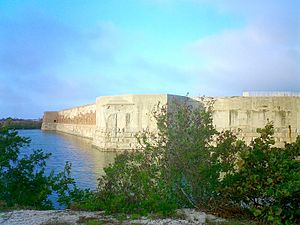
During the American Civil War, Florida joined the Confederate States of America. However, Key West stayed under the control of the U.S. Union because of its naval base. Many local people supported the Confederacy. They even flew Confederate flags over their homes. Key West also had a large population of free black people. This group grew during the war as more enslaved black people escaped to the safety of the Union soldiers there.
Fort Zachary Taylor was built between 1845 and 1866. It was a very important outpost for Key West during the Civil War. In 1861, two other forts, East and West Martello Towers, began construction. They served as smaller armories and batteries for the main fort. They were connected to Fort Taylor by railroad tracks to move supplies. In 1864, 900 men from the 2nd United States Colored Troops (USCT) arrived in Key West. Many of these men fought in southern Florida. The 2nd USCT became one of the most active black regiments in Florida.
Fort Jefferson, located about 68 miles (109 km) from Key West, was a prison after the Civil War. Dr. Samuel A. Mudd was imprisoned there. He was found guilty of helping John Wilkes Booth, who assassinated President Abraham Lincoln.
In the 1800s, Key West's main industries included salvaging shipwrecks, fishing, catching turtles, and making salt. From 1830 to 1861, Key West was a big center for salt production in the U.S. They got salt from the sea. During the Civil War, Union troops stopped the salt industry. This was because Confederate supporters were smuggling salt to the South. Salt production started again after the war. But a hurricane in 1876 destroyed the industry. It never fully recovered, partly because new salt mines were found on the mainland.
During the Ten Years' War (a Cuban war for independence in the 1860s and 1870s), many Cubans came to Key West for safety. Several cigar factories moved from Cuba to Key West. Key West quickly became a major producer of cigars. A big fire on April 1, 1886, destroyed 18 cigar factories and many homes. Some factory owners moved their businesses to Ybor City in Tampa. This caused the cigar industry in Key West to slowly decline. Still, Key West was the largest and wealthiest city in Florida in the late 1880s.
The USS Maine sailed from Key West to Havana. It then exploded and sank in Havana Harbor. This event helped start the Spanish–American War. Crew members from the ship are buried in Key West. The Navy's investigation into the explosion happened at the Key West Customs House.
Key West in the 1900s
In October 1909, a hurricane badly damaged Key West. Another hurricane in 1910 caused more damage.
Key West was quite isolated until 1912. That year, it was connected to mainland Florida by the Overseas Railroad. This was an extension of Henry M. Flagler's Florida East Coast Railway. Flagler created new land at Trumbo Point for his train yards.
Another hurricane in 1919 caused huge damage to the city.
Pan American Airlines was started in Key West in 1926. It first flew visitors to Havana. In 1927, the airline began delivering mail between Cuba and the United States. This mail route was called the Key West, Florida – Havana Mail Route.
The 1935 Labor Day hurricane destroyed much of the Overseas Railway. It also killed hundreds of people. This included about 400 World War I veterans. They were living in camps and working on road projects in the Middle Keys. The railway company could not afford to rebuild the tracks.
The U.S. government then rebuilt the route as a highway for cars. It was finished in 1938. This highway was built on many of the old railroad foundations. It became an extension of U.S. Route 1. The part of U.S. 1 through the Keys is called the Overseas Highway. Franklin D. Roosevelt toured the road in 1939.
During World War II, more than 14,000 ships used the island's harbor. The population of Key West sometimes doubled or tripled during the war. This was due to many soldiers, sailors, workers, and tourists arriving.
Starting in 1946, U.S. President Harry S. Truman used a house in Key West as his working vacation home. It was called the Harry S. Truman Little White House. He spent 175 days of his presidency there.
In 1948, Key West was hit by two hurricanes in two months. These were the September 1948 Florida hurricane and the 1948 Miami hurricane.
Before the Cuban Revolution in 1959, there were regular ferry and airplane services. These connected Key West and Havana.
John F. Kennedy often mentioned Key West being "90 miles from Cuba" in his speeches against Fidel Castro. Kennedy himself visited Key West in November 1962. This was one month after the Cuban Missile Crisis ended.
In 1982, the city of Key West briefly declared itself independent. It called itself the Conch Republic. This was a protest against a United States Border Patrol blockade. The Border Patrol had set up a checkpoint on U.S. Route 1. They stopped every car leaving the Keys, looking for illegal immigrants. This caused a 17-mile (27 km) traffic jam. It hurt the tourism industry in the Florida Keys. Today, flags and souvenirs of the Conch Republic are still popular. The Conch Republic Independence Celebration is held every year on April 23.
In 1998, Hurricane Georges caused damage to the city. In 2017, Hurricane Irma caused significant damage with wind and flooding. Three people lost their lives.
Key West's Location and Features
 |
Sunset Key, Wisteria Island | Gulf of Mexico, Fleming Key, Sigsbee Park | North Stock Island, Key Haven |  |
| Gulf of Mexico, Marquesas Keys | Stock Island, Cow Key | |||
| Gulf of Mexico, Sand Key | Atlantic Ocean | Atlantic Ocean |
Key West is an island located at 24°33′55″N 81°46′33″W / 24.565176°N 81.775794°W in the Straits of Florida. The island is about 4 miles (6.4 km) long and 1 mile (1.6 km) wide. Its total land area is about 4.2 square miles (10.9 km2). The island's average height above sea level is about 8 feet (2.4 m). The highest point is about 18 feet (5.5 m) high. This spot is called Solares Hill.
Key West is the southernmost city in the contiguous United States. It is also the westernmost island in the Florida Keys connected by a highway. The city includes Key West island and several nearby islands. It also includes the northern part of Stock Island. The city's total land area is 5.6 square miles (14.5 km2). Sigsbee Park (also known as Dredgers Key) and Fleming Key are to the north. Sunset Key is to the west. All these are part of the city. Fleming Key and Sigsbee Park are part of Naval Air Station Key West. They are not open to the public.
In the late 1950s, many large salt ponds on the eastern side of the island were filled in. This new area is called New Town. It has shopping centers, homes, schools, and the Key West International Airport.
Key West and most of the Florida Keys are on the line between the Atlantic Ocean and the Gulf of Mexico. These two bodies of water have different currents. The Gulf of Mexico is calmer and warmer. The area where they meet, between Key West and Cuba, is called the Straits of Florida. The warmest ocean waters on the U.S. mainland are found in the Florida Keys in winter. Sea temperatures average 75–77 °F (24–25 °C) from December to February.
Duval Street, the main street, is 1.1 miles (1.8 km) long. It crosses from the Gulf of Mexico to the Straits of Florida and the Atlantic Ocean.
Key West is closer to Havana (about 106 miles or 171 km by air or sea) than it is to Miami (130 miles or 209 km by air). Key West is often the end point for marathon swims from Cuba. This includes Diana Nyad's record-setting swim in 2013. She was the first to complete it without a shark cage or fins.
Cool Places to Visit in Key West
Old Town Charm
The oldest neighborhoods in Key West are in the western part of the island. They are known as Old Town. This area has the main tourist spots. These include Mallory Square, Duval Street, the Truman Annex, and Fort Zachary Taylor. Old Town is where you can find classic bungalows and guest houses. Bahama Village, southwest of Whitehead Street, has houses and churches related to its Afro-Bahamian history. The Meadows, northeast of the White Street Gallery District, is mostly homes.
Most buildings here were built between 1886 and 1912. They are usually one to two-and-a-half stories tall. They are made of wood and sit on piers about 3 feet (0.9 m) above the ground. They often have peaked metal roofs, wood siding, fancy "gingerbread" trim, and pastel colors. They also have louvered shutters and covered porches.
Some older buildings still exist. These include the Oldest House (built 1829–1836) and the John Huling Geiger House (built 1846–1849). The Geiger House is now the Audubon House and Tropical Gardens. Forts like Fort Zachary Taylor, the East Martello Tower, and the West Martello Tower helped the Union keep control of Key West during the Civil War. Another important building built by the government is the Key West Lighthouse, which is now a museum.
Two very famous buildings in Old Town belonged to important people. One is the Ernest Hemingway House, where the writer lived from 1931 to 1939. The other is the Harry S. Truman Little White House. President Truman spent 175 days of his time in office there. Many historical homes of Key West families are also recognized. These include the Dr. Joseph Y. Porter House and the Eduardo H. Gato House.
Several homes of the Curry family are still standing. This includes the Benjamin Curry House. Benjamin was the brother of William Curry, Florida's first millionaire. The Southernmost House and the Fogarty Mansion were built by William Curry's children.
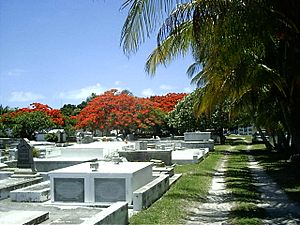
Besides the buildings, Old Town also has the Key West Cemetery. It was started in 1847. It has above-ground tombs and interesting sayings on the gravestones. Some people who died in the 1898 explosion of the USS Maine are buried there.
Casa Marina Area
The Casa Marina area gets its name from the Casa Marina Hotel. This hotel opened in 1921 and is the most famous building there. The Reynolds Street Pier, Higgs Beach, the West Martello Tower, the White Street Pier, and Rest Beach are all along the waterfront.
Southernmost Point in the U.S.
One of the most popular places to visit is a concrete buoy at South and Whitehead Streets. It claims to be the southernmost point in the contiguous United States. This spot was first marked with a simple sign. The city of Key West put up the current monument in 1983. After Hurricane Irma in 2017, the monument was repainted. It is the most photographed tourist spot in the Florida Keys.
The monument says "Southernmost point continental U.S.A." However, the actual southernmost point of Key West is Whitehead Spit. This is on the Truman Annex property, just west of the buoy. This spit has no marker because it is on U.S. Navy land. Tourists cannot enter it. Private property next to the buoy and the beaches of Truman Annex and Fort Zachary Taylor Historic State Park are also farther south than the buoy. The southernmost point in the contiguous United States that the public can visit is the beach at Fort Zachary Taylor park. The true southernmost land is Ballast Key, a private island.
The monument also says "90 Miles to Cuba". However, Key West and Cuba are actually about 95 miles (153 km) apart at their closest points. The distance from the monument to Havana is about 90 nautical miles (104 miles or 167 km).
Key West Library
The first public library in Key West opened in 1853. It was located in the Masonic Temple on Simonston Street. The library had 1,200 books for people to read.
In 1919, a hurricane destroyed the library. Key West residents moved the library to different places around the island. In 1959, the county took over and found a permanent home for the library on Fleming Street. It is still there today. At that time, there was also a bookmobile service that served all the Keys.
The Key West Library now has over 70,000 items. One special item is a letter from singer/songwriter Jimmy Buffett. In his letter from 1984, he thanked the library for inspiring his songs and for its air conditioning. As of 2022, the Key West Library is part of the Monroe County Public Library System.
Famous Homes in Key West
The Little White House
Several U.S. presidents have visited Key West. The first was Ulysses S. Grant in 1880. Then came Grover Cleveland in 1889, and William Howard Taft in 1912. Taft was the first president to use the building that later became the Little White House. Franklin D. Roosevelt visited the Florida Keys many times, starting in 1917.
Harry S. Truman visited Key West for a total of 175 days during his presidency. He made 11 visits and came back five times after leaving office. His first visit was in 1946. The Little White House and Truman Annex are named after his many visits. The house is also known as the Winter White House. Truman stayed there mostly in the winter and used it for official work, like signing the Truman Doctrine.
Dwight D. Eisenhower stayed at the Little White House in 1955 after having a heart attack. John F. Kennedy visited Key West in March 1961 and again in November 1962. His second visit was a month after the Cuban Missile Crisis was resolved. Jimmy Carter visited the Little White House twice with his family after his presidency, in 1996 and 2007.
Ernest Hemingway's House
It is said that famous writer Ernest Hemingway wrote part of his book A Farewell to Arms in Key West. He lived above a Ford car dealership at 314 Simonton Street. This was while he waited for a new car in 1928.
A hardware store owner named Charles Thompson taught Hemingway about deep-sea fishing. One of the people who went fishing with him was Joe Russell, also known as Sloppy Joe. Russell is believed to be the inspiration for a character in Hemingway's book To Have and Have Not. Parts of the original book manuscript were found at Sloppy Joe's Bar after Hemingway's death. The fishing group gave each other nicknames, and Hemingway was called "Papa."
Pauline's rich uncle, Gus Pfeiffer, bought the 907 Whitehead Street house in 1931 as a wedding gift for Hemingway and his wife Pauline. The Hemingways added a swimming pool in 1937–38. It cost $20,000, which was a lot of money back then. Hemingway supposedly put a penny in the wet cement of the patio, saying, "Here, take the last penny I've got!" You can still see the penny at the north end of the pool.
While living there, Hemingway wrote or worked on several famous books. These include Death in the Afternoon, For Whom the Bell Tolls, The Snows of Kilimanjaro, and The Short Happy Life of Francis Macomber. He used Key West during the Great Depression as a setting in To Have and Have Not. This was his only novel with scenes that take place in the United States.
The house is still home to many polydactyl cats. These cats have six or seven toes. They are descendants of Hemingway's original pet cat, "Snowball." They are cared for at the Hemingway House. The Key West City Commission has made a special rule for the house. It allows them to have more than four domestic animals, even though there's a law against it.
Pauline and Hemingway divorced in 1939. Hemingway only visited the house sometimes when he returned from Havana. He passed away in 1961.
Tennessee Williams' House
Tennessee Williams, another famous writer, started visiting Key West regularly in 1941. He is said to have written the first version of his play A Streetcar Named Desire in 1947 while staying at the La Concha Hotel. He bought a house in 1949 and lived in Key West until he passed away in 1983. Unlike Hemingway's large house, Williams' home at 1431 Duncan Street is a very simple bungalow. It is privately owned and not open to the public. The movie The Rose Tattoo, based on his play, was filmed on the island in 1956. The Tennessee Williams Theatre is located at the College of the Florida Keys on Stock Island.
Even though Hemingway and Williams lived in Key West at the same time, they only met once. This meeting happened at Hemingway's home in Cuba.
Key West's Port and Ships
The Port of Key West includes Key West Bight and Garrison Bight at City Marina. It also has three docks for cruise ships.
The first cruise ship to use the port was the Sunward in 1969. It docked at Pier B, which the U.S. Navy owned at the time.
In 1984, the city opened a cruise terminal at Mallory Square. Some people did not like this decision. They said it would ruin the tradition of watching the sunset at Mallory Square.
In 2013, people voted against a plan to make the ship channel wider. 73% of voters said no. The plan would have allowed bigger cruise ships. It would have also needed digging up 17 acres (6.9 ha) of the sea bottom. This area includes endangered corals in the protected Florida Keys National Marine Sanctuary.
In 2020, Key West voters approved three changes to the City Charter. These changes stop large cruise ships, limit how many people can get off ships each day, and prefer cruise ships with good health and environmental records. These changes were supported by the Key West Committee for Safer, Cleaner Ships. They passed with 61% to 81% approval.
Key West's Weather and Climate
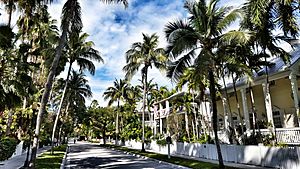
Key West has a tropical savanna climate. This means it has two main seasons: wet and dry. Unlike many places, Key West has only a small difference in average monthly temperatures. The coolest month is January, and the warmest is July. The yearly change in average monthly temperatures is about 15 °F (8.3 °C).
According to the National Weather Service, the Florida Keys and Miami Beach are the only places in the contiguous United States that have never had frost or freezing temperatures. The lowest temperature ever recorded in Key West was 41 °F (5 °C). This happened on January 12, 1886, and January 13, 1981.
Strong easterly tradewinds and sea breezes keep the summer heat down. Temperatures rarely reach 95 °F (35 °C). There are about 56 days a year with highs of 90 °F (32 °C) or more. This period is usually from June 8 to September 24. This is shorter than almost all of the southeastern U.S. However, low temperatures often stay above 80 °F (27 °C). The highest temperature ever recorded was 97 °F (36 °C). This happened on July 19, 1880, and August 29, 1956.
Wet and Dry Seasons
Key West has a wet and dry season, like most tropical climates. From November through April, it is usually sunny and very dry. Only about 25% of the yearly rain falls during this time. May through October is normally the wet season. During this time, it often rains almost every day. These are usually short but heavy tropical downpours, followed by strong sunshine. These showers often happen in the early morning. This is different from mainland Florida, where storms usually occur in the afternoon. Sometimes, tropical waves bring a lot of rain. Rare hurricanes can also bring very heavy rainfall. On average, rain peaks between August and October. September is the wettest month in Key West. This is when the risk from tropical storms and hurricanes is highest. Key West is the driest city in Florida. It gets just over 40 inches (1,016 mm) of rain each year. This is because it is relatively dry in May, June, and July. In mainland Florida, cities like Orlando and Tampa usually get 7 to 10 inches (178 to 254 mm) of rain in June and July. Key West gets only half that amount during the same time.
Hurricanes and Key West
Key West, like the rest of the Florida Keys, can be affected by hurricanes. In recent years, the island has not been hit too hard by major storms. The most recent hurricane to affect Key West was Hurricane Irma. It hit the Keys on September 10, 2017, as a Category 4 storm.
Some local people say that Hurricane Wilma on October 24, 2005, was the worst storm they remember. The entire island was told to leave. Business owners had to close their shops. After the hurricane passed, the storm surge brought 8 feet (2.4 m) of water inland. This completely flooded a large part of the lower Keys. Low-lying areas of Key West, including popular tourist spots, were under as much as 3 feet (0.9 m) of water. Sixty percent of homes in Key West were flooded. The higher parts of Old Town, like Solares Hill and the Key West Cemetery, did not flood. This was because they are 12 to 18 feet (3.7 to 5.5 m) higher. The storm surge destroyed tens of thousands of cars. Many houses were flooded with 1 to 2 feet (30 to 61 cm) of seawater. A local newspaper called Key West and the lower Keys a "car graveyard." The highest part of the storm surge happened after the eye of Wilma had already passed over Naples. The winds during the surge were less than 40 miles per hour (64 km/h). The storm destroyed the piers at the Atlantic Shores Motel. It also broke the shark tank at the Key West Aquarium, letting the sharks escape. The damage caused the island's famous Halloween Fantasy Fest to be postponed until December. MTV's show The Real World: Key West was filming during the hurricane and showed the storm.
In September 2005, NOAA opened its National Weather Forecasting building on White Street. This building is designed to withstand a Category 5 hurricane and its storm surge.
The most intense hurricane before Wilma was Hurricane Georges. It was a Category 2 storm in September 1998. It damaged many houseboats along "Houseboat Row" on South Roosevelt Boulevard. This area is near Cow Key channel on the east side of the island.
| Climate data for Key West Int'l, Florida (1981–2010 normals, extremes 1872−present) | |||||||||||||
|---|---|---|---|---|---|---|---|---|---|---|---|---|---|
| Month | Jan | Feb | Mar | Apr | May | Jun | Jul | Aug | Sep | Oct | Nov | Dec | Year |
| Record high °F (°C) | 90 (32) |
87 (31) |
89 (32) |
91 (33) |
93 (34) |
96 (36) |
97 (36) |
97 (36) |
95 (35) |
93 (34) |
91 (33) |
88 (31) |
97 (36) |
| Mean maximum °F (°C) | 82.0 (27.8) |
82.7 (28.2) |
84.2 (29.0) |
86.0 (30.0) |
88.6 (31.4) |
91.0 (32.8) |
92.0 (33.3) |
92.1 (33.4) |
91.1 (32.8) |
88.7 (31.5) |
85.6 (29.8) |
82.7 (28.2) |
92.6 (33.7) |
| Mean daily maximum °F (°C) | 74.3 (23.5) |
76.0 (24.4) |
78.2 (25.7) |
81.3 (27.4) |
85.0 (29.4) |
87.8 (31.0) |
89.3 (31.8) |
89.4 (31.9) |
87.9 (31.1) |
84.5 (29.2) |
79.9 (26.6) |
76.0 (24.4) |
82.5 (28.1) |
| Daily mean °F (°C) | 69.3 (20.7) |
71.0 (21.7) |
73.2 (22.9) |
76.4 (24.7) |
80.3 (26.8) |
83.3 (28.5) |
84.5 (29.2) |
84.5 (29.2) |
83.2 (28.4) |
80.2 (26.8) |
75.8 (24.3) |
71.4 (21.9) |
77.8 (25.4) |
| Mean daily minimum °F (°C) | 64.2 (17.9) |
66.0 (18.9) |
68.3 (20.2) |
71.6 (22.0) |
75.7 (24.3) |
78.8 (26.0) |
79.8 (26.6) |
79.6 (26.4) |
78.5 (25.8) |
76.0 (24.4) |
71.7 (22.1) |
66.9 (19.4) |
73.1 (22.8) |
| Mean minimum °F (°C) | 51.0 (10.6) |
53.7 (12.1) |
57.4 (14.1) |
61.9 (16.6) |
69.5 (20.8) |
73.4 (23.0) |
74.1 (23.4) |
73.8 (23.2) |
73.6 (23.1) |
69.1 (20.6) |
62.2 (16.8) |
54.5 (12.5) |
48.8 (9.3) |
| Record low °F (°C) | 41 (5) |
44 (7) |
47 (8) |
48 (9) |
63 (17) |
65 (18) |
68 (20) |
68 (20) |
64 (18) |
59 (15) |
49 (9) |
44 (7) |
41 (5) |
| Average rainfall inches (mm) | 2.04 (52) |
1.49 (38) |
2.05 (52) |
2.05 (52) |
3.00 (76) |
4.11 (104) |
3.55 (90) |
5.38 (137) |
6.71 (170) |
4.93 (125) |
2.30 (58) |
2.22 (56) |
39.83 (1,012) |
| Average rainy days (≥ 0.01 in) | 6.2 | 5.3 | 5.8 | 4.5 | 7.2 | 11.0 | 11.7 | 14.2 | 16.2 | 11.3 | 6.6 | 6.4 | 106.4 |
| Average relative humidity (%) | 76.0 | 74.3 | 73.0 | 70.1 | 71.8 | 74.0 | 72.2 | 73.4 | 75.3 | 75.1 | 76.0 | 76.2 | 74.0 |
| Mean monthly sunshine hours | 249.6 | 245.4 | 308.8 | 324.6 | 340.3 | 314.0 | 325.2 | 306.6 | 269.6 | 254.7 | 230.9 | 234.5 | 3,404.2 |
| Percent possible sunshine | 75 | 77 | 83 | 85 | 82 | 77 | 78 | 76 | 73 | 71 | 70 | 71 | 77 |
| Source: NOAA (relative humidity and sun 1961−1990) , The Weather Channel | |||||||||||||
| Climate data for Key West | |||||||||||||
|---|---|---|---|---|---|---|---|---|---|---|---|---|---|
| Month | Jan | Feb | Mar | Apr | May | Jun | Jul | Aug | Sep | Oct | Nov | Dec | Year |
| Average sea temperature °F (°C) | 71.2 (21.8) |
71.2 (21.8) |
73.2 (22.9) |
77.7 (25.4) |
80.6 (27.0) |
83.3 (28.5) |
85.5 (29.7) |
86.9 (30.5) |
85.5 (29.7) |
82.8 (28.2) |
78.4 (25.8) |
74.5 (23.6) |
79.2 (26.2) |
| Mean daily daylight hours | 11.0 | 11.0 | 12.0 | 13.0 | 13.0 | 14.0 | 13.0 | 13.0 | 12.0 | 12.0 | 11.0 | 11.0 | 12.2 |
| Average Ultraviolet index | 6 | 8 | 10 | 11 | 11 | 11 | 11 | 11 | 10 | 9 | 7 | 6 | 9.3 |
| Source: Weather Atlas | |||||||||||||
Key West's People
| Historical population | |||
|---|---|---|---|
| Census | Pop. | %± | |
| 1840 | 688 | — | |
| 1850 | 2,367 | 244.0% | |
| 1860 | 2,832 | 19.6% | |
| 1870 | 5,016 | 77.1% | |
| 1880 | 9,890 | 97.2% | |
| 1890 | 18,080 | 82.8% | |
| 1900 | 17,114 | −5.3% | |
| 1910 | 19,945 | 16.5% | |
| 1920 | 18,749 | −6.0% | |
| 1930 | 12,831 | −31.6% | |
| 1940 | 12,927 | 0.7% | |
| 1950 | 26,433 | 104.5% | |
| 1960 | 33,956 | 28.5% | |
| 1970 | 29,312 | −13.7% | |
| 1980 | 24,382 | −16.8% | |
| 1990 | 24,832 | 1.8% | |
| 2000 | 25,478 | 2.6% | |
| 2010 | 24,649 | −3.3% | |
| 2020 | 26,444 | 7.3% | |
| U.S. Decennial Census | |||
Population and Backgrounds
| Race | Pop 2010 | Pop 2020 | % 2010 | % 2020 |
|---|---|---|---|---|
| White (NH) | 16,286 | 16,160 | 66.07% | 61.11% |
| Black or African American (NH) | 2,215 | 2,562 | 8.99% | 9.69% |
| Native American or Alaska Native (NH) | 84 | 59 | 0.34% | 0.22% |
| Asian (NH) | 386 | 609 | 1.57% | 2.30% |
| Pacific Islander or Native Hawaiian (NH) | 34 | 35 | 0.14% | 0.13% |
| Some other race (NH) | 44 | 186 | 0.18% | 0.70% |
| Two or more races/Multiracial (NH) | 372 | 904 | 1.51% | 3.42% |
| Hispanic or Latino (any race) | 5,228 | 5,929 | 21.21% | 22.42% |
| Total | 24,649 | 26,444 |
In 2020, Key West had 26,444 people living in 10,788 households. There were 5,701 families. In 2010, there were 24,649 people in 9,388 households and 4,813 families.
| Ancestry in Key West (2014–2018) | ||||
|---|---|---|---|---|
| Ancestral origin: | Percent: | |||
| English American (including "American" ancestry) | 14% | |||
| Cuban American | 12.7% | |||
| German American | 10.1% | |||
| Irish American | 7.9% | |||
| Italian American | 6.2% | |||
| West Indian Americans (excluding Hispanic groups) | 5.7% | |||
| African American | 4.8% | |||
| Mexican American | 4.2% | |||
| Central American | 4% | |||
| Polish American | 3.7% | |||
| Scottish American (including Scots-Irish) | 2.8% | |||
| Puerto Rican American | 2.7% | |||
| Central European (including Slavic, Slovakian, Slovenian, Czech, etc.) | 2.3% | |||
Who are the "Conchs"?
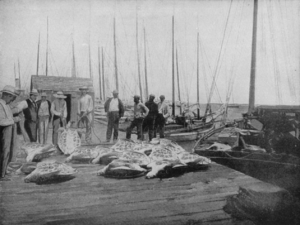
Many early residents of Key West were immigrants from the Bahamas. They were called Conchs (pronounced "conks"). They came in large numbers after 1830. Many were descendants of Loyalists who moved to British land during the American Revolution. In the 1900s, many Key West residents started calling themselves Conchs. Now, the term is generally used for anyone living in Key West.
Some people use "Conch" (or "Saltwater Conch") for someone born in Key West. A "Freshwater Conch" is someone who has lived in Key West for seven or more years but was not born there. The original meaning of Conch only applied to people with European ancestors who came from the Bahamas. It is said that when a baby was born, the family would put a conch shell on a pole in front of their home.
Many black Bahamian immigrants who arrived later lived in Bahama Village. This area of Old Town is next to the Truman Annex.
Cuban Influence in Key West
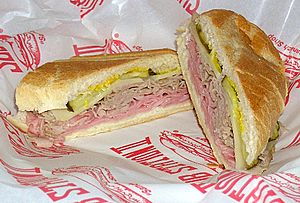
Key West is closer to Havana (106 miles or 171 km) than it is to Miami (130 miles or 209 km). In 1890, Key West had almost 18,800 people. It was the biggest and richest city in Florida. Half of the residents were said to be of Cuban origin. Key West often had Cuban mayors. This included the son of Carlos Manuel de Céspedes, who is called the father of the Cuban Republic. He was elected mayor in 1876.
Cubans were very active in the city's businesses. There were reportedly 200 factories making 100 million cigars each year. José Martí visited Key West several times starting in 1891. He came to find people to support Cuban independence. He also founded the Cuban Revolutionary Party during his visits to Key West.
Key West received many refugees during the Mariel Boatlift. Refugees still arrive. In April 2003, hijacked Cuban Airlines planes even landed at the city's airport.
Military Presence in Key West
NAS Key West, Boca Chica, and the Truman Annex have been home to U.S. ships, submarines, and training squadrons. This includes the current VFC-111 "Sundowners" and the former VFP-62 "Fighting Photos" during the Cuban Missile Crisis. NAS Key West is still a training facility for U.S. Naval Aviation personnel.
Key West has had a military presence since 1823. This was shortly after John Simonton bought it in 1822. Simonton asked the U.S. government to build a naval base in Key West. This would use its important location and bring order to the town. On March 25, 1822, naval officer Matthew C. Perry sailed to Key West. He raised the U.S. flag, claiming the Keys for the United States. In 1823, a naval base was set up. It protected shipping merchants in the lower Keys from pirates. This base grew through the Civil War, the Spanish American War, two world wars, and the Cold War. It became Naval Station Key West. It was home to the Fleet Sonar School, Marine Barracks Key West, and many ships and submarines.
NAVSTA Key West closed in 1974. This was part of reducing military forces after the Vietnam War. Part of the original NAVSTA Key West is still under Navy control as Naval Air Station Key West-Truman Annex. Another part, Fort Zachary Taylor, was given to the State of Florida as a state park. The Truman Little White House has also been kept as a museum. This is because President Harry S. Truman used it as a part-time home. The rest of the original base was given to private developers and the city of Key West. It now includes The Key West Amphitheater, Truman Waterfront Park, homes, and part of Mallory Square.
Key West was always an important military post. It sits at the northern edge of the deepwater channel. This channel connects the Atlantic and the Gulf of Mexico through the Florida Straits. The southern edge of this channel is 90 miles (145 km) away in Cuba. Because of this, Key West has been called the "Gibraltar of the West" since the 1820s. Fort Taylor was first built on the island. The Navy added a small base. From this base, the USS Maine sailed to its destruction in Havana. This happened at the start of the Spanish–American War. This base later became NAVSTA Key West.
At the start of World War II, the Navy greatly increased its presence. It grew from 50 acres (20 ha) to 3,000 acres (1,214 ha). This included all of Boca Chica Key's 1,700 acres (688 ha). They also built Fleming Key using landfill. The Navy built the first water pipeline along the Keys. This brought fresh water from the mainland to supply its bases. At its busiest, 15,000 military personnel and 3,400 civilians were at the base. The base includes:
- Naval Air Station Key West – This is the main facility on Boca Chica. Its main job is to train pilots and flight officers for carrier-based planes. They practice air combat training before going overseas. Another squadron, Fighter Composite Squadron 111 (VFC-111), is based here. Its pilots fly F-5 Tiger II aircraft as simulated enemy planes for training. In 2006, there were 1,650 active duty personnel, 2,507 family members, 35 Reserve members, and 1,312 civilians at the base. In the 1990s, the Navy agreed with the National Park Service to stop sonic booms near Fort Jefferson in the Dry Tortugas. Many training missions are aimed at the Marquesas "Patricia" Target. This is a grounded ship wreck 29 nautical miles (54 km) west of the base. It is 306 feet (93 m) long and only visible at low tide. Bombs are not actually dropped on it.
- Truman Annex – This area next to Fort Taylor became a submarine base. It was also used for the Fleet Sonar School. President Harry S. Truman made the commandant's house his winter White House. The Fort Taylor Annex was later renamed the Truman Annex. Most of this area has been closed down. Fort Zachary Taylor was given to the State of Florida as a state park. The rest was given to private developers and the city of Key West. There are still some military and U.S. government offices here. This includes the new NOAA Hurricane Forecasting Center. The Navy still owns its piers.
- Trumbo Point Annex – This docking area was once the railroad yard for Flagler's Overseas Railroad. Now, the Coast Guard uses it as Coast Guard Sector Key West and Coast Guard Station Key West. It is home to several Coast Guard ships. It also has housing for Navy officers and military families.
Media and Education in Key West
Local Media
Key West is part of the Miami-Fort Lauderdale television market. It gets TV signals from rebroadcast transmitters in Key West and Marathon. These repeat the Miami-Fort Lauderdale stations. Comcast provides cable television service. DirecTV and Dish Network offer Miami-Fort Lauderdale local stations and national channels.
The Key West area has 11 FM radio stations, 4 FM translators, and 2 AM stations. WEOW 92.7 has a popular morning show. SUN 99.5 has an afternoon show. Island 106.9 FM is the only locally owned, independent FM station in Key West. It plays alternative rock music and has community programs.
The Florida Keys Keynoter and the Key West Citizen are local newspapers. They serve Key West and Monroe County. The Southernmost Flyer is a weekly paper. It is made by the Public Affairs Department of Naval Air Station Key West. It serves the local military community. Key West the Newspaper (also known as The Blue Paper) is a local weekly newspaper that investigates stories. It was started in 1994 by Dennis Cooper. In 2013, Arnaud and Naja Girard took it over as a digital publication.
In October 2022, TheKeys411.com launched KeyWestPlus.com, or KeyWest+, on Roku. This channel shows local musicians, interesting people, and lifestyle topics in Key West and The Florida Keys.
Schools and Learning
The Monroe County School District runs public schools in Key West.
Elementary schools in Key West include Poinciana Elementary School (on Key West island) and Gerald Adams Elementary School (on Stock Island). Middle and high schools include Horace O'Bryant School, which is now a K–8 school, and Key West High School. All of Key West is assigned to Horace O'Bryant School for grades 6–8 and to Key West High School for grades 9–12. Sigsbee Charter School is a K–8 school. It is approved by the District and mainly serves children of military families. It also accepts other children from the community. Getting into Sigsbee Charter School is limited, and a lottery system manages the waiting list. Key West Montessori Charter School is another approved charter school on Key West Island.
The main campus of the College of the Florida Keys (formerly Florida Keys Community College) is located in Key West.
Famous People from Key West
Key West has been home to or visited by many famous people, including presidents and writers. Their stories are part of the island's unique history.
See also
 In Spanish: Cayo Hueso (Florida) para niños
In Spanish: Cayo Hueso (Florida) para niños


